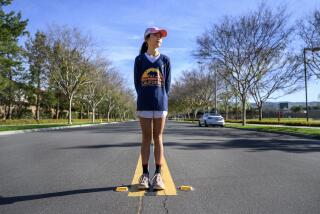Young Athletes’ Development Studied : Health: Researchers say children are not capable of quick bursts of power until puberty, when “fast-twitch” muscle fibers develop. But all can do aerobic exercise, they say.
- Share via
WASHINGTON — All healthy children are potential aerobic athletes--at least until they mature enough to be something else, a researcher says.
Some could grow into distance runners while others become sprinters or weightlifters; however, the difference doesn’t start to emerge until early puberty, said Dr. Oded Bar-Or.
Before puberty, children are more capable of extended runs and other aerobic exercise, Bar-Or said. Kids at play tend not to run for more than seconds, but studies show they can handle longer efforts if they want, he said.
The change appears as boys develop more of what are termed fast-twitch muscle fibers that generate bursts of power, the Canadian researcher said. As girls grow into women, their fast-twitch fibers develop as well, but to a lesser extent.
Puberty thus leads to what’s termed specialization, as some athletes develop an ability to compete in sports that favor fast-twitch muscle fibers and others compete in aerobic activities based on what are termed slow-twitch fibers.
This means there’s little value in trying to focus children’s exercise programs toward developing adult power-sport champions before children develop fast-twitch fibers, said Bar-Or, professor of pediatrics and director of the Children’s Exercise and Nutrition Center at McMaster University in Hamilton, Ontario.
Children can benefit from weight training, but it seems that the exercise mostly trains nerves to recruit more muscle fiber to respond, rather than making muscle grow, Bar-Or said. Young athletes do well in explosive-power sports such as gymnastics because the events rely on coordination, he said.
“Relatively speaking, we feel their lungs and heart are more developed than their muscles--and lungs and heart is really what we mean by aerobic fitness,” Bar-Or said.
Bar-Or and Israeli colleague Bareket Falk attempted to find the time in a young athlete’s life at which specialization starts. Their study was published in Pediatric Exercise Science, the journal of the North American Society of Pediatric Exercise Medicine.
The study followed 31 young people, approximately 11 to 18 years old, over 18 months. The subjects were classified by stage--pre-, middle- or late-puberty. They were tested at least four times on their aerobic and anaerobic abilities.
Early and middle pubescents had the greatest differences in ability, the study said. This means anaerobic development in these younger pubescents was coming along faster than the increase in aerobic development, Bar-Or said. The increase in late puberty was minor by comparison.
Bar-Or and Falk found wide variations in anaerobic development from individual to individual. Sprinting and weight-lifting, for example, are considered anaerobic activity.
When they tried to track the development as the younger subjects grew older, they found they didn’t have enough cases to draw statistically valid conclusions.
But when the paper is placed in the context of similar projects, a pattern of anaerobic development in early puberty emerges, Bar-Or said.
The study gives strong evidence that prepubescents have not begun the specialization process, said Dr. Lyle J. Micheli, director of the division of sports medicine at Children’s Hospital in Boston.
But it does not answer another question--the possible effect of exercise training, or whether specialization takes place simply as part of normal growth and development, Micheli said.





